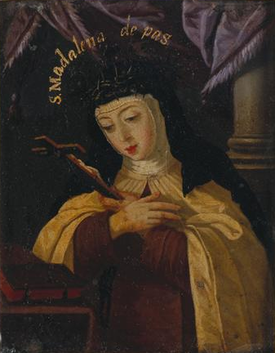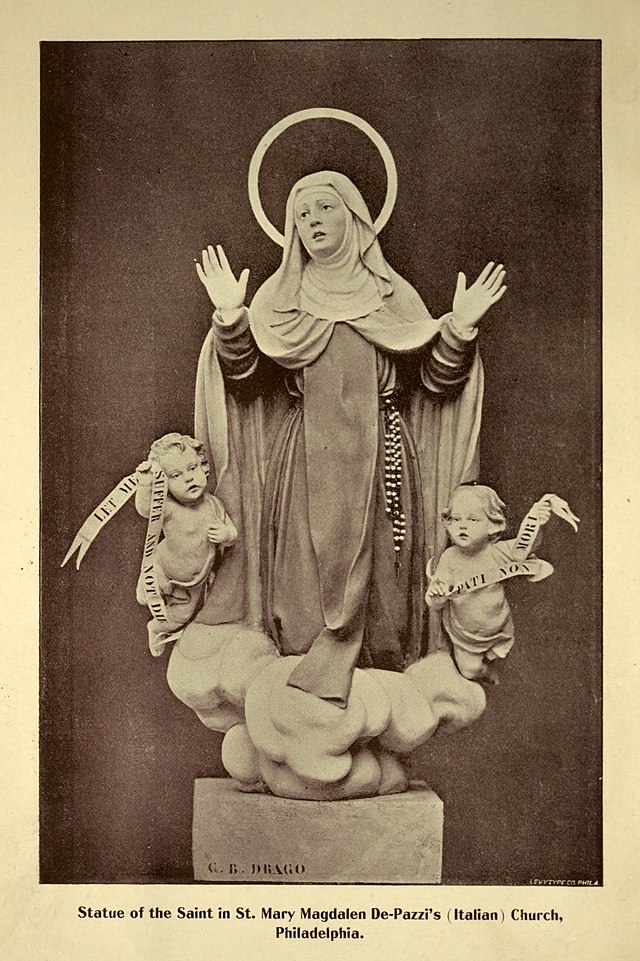Mary Magdalene de' Pazzi, OCarm (Italian: Maria Maddalena de' Pazzi; born Caterina Lucrezia de' Pazzi; 2 April 1566 – 25 May 1607), was an Italian Carmelite nun and mystic. She has been declared a saint by the Catholic Church.
Mary Magdalene de' Pazzi | |
|---|---|
 17th-century miniature by Josefa de Óbidos (1630-1684). | |
| Virgin | |
| Born | Caterina Lucrezia de' Pazzi 2 April 1566 Florence |
| Died | 25 May 1607 (aged 41) Florence |
| Venerated in | Catholic Church |
| Beatified | 1626, Rome by Pope Urban VIII |
| Canonized | 28 April 1669, Rome by Pope Clement X |
| Major shrine | Monastery of Santa Maria Maddalena de' Pazzi, Careggi, Florence |
| Feast | 25 May (29 May from 1728 to 1969) |



Life
De' Pazzi was born at Florence, Italy, on 2 April 1566,[1] to Camillo di Geri de' Pazzi, a member of one of the wealthiest and most distinguished noble families of Renaissance Florence, and Maria Buondelmonti. She was christened Caterina Lucrezia, but in the family was called with her second name, out of respect for her paternal grandmother, Lucrezia Mannucci.[2]
At the age of nine de' Pazzi was taught how to meditate by the family chaplain, using a then-recently published work explaining how one should meditate on the Passion of Christ. Years later, this book was one of the items she brought with her to the monastery.[2] Around the age of nine is also when de' Pazzi began practicing mortification of the flesh through self-flagellation, wearing a barbed metal cilice, and wearing a home-made crown of thorns.[3] She received her First Communion at the then-early age of 10 and made a vow of virginity the same year.[3] She experienced her first ecstasy when she was only twelve, in her mother's presence. From then on, she continued to exhibit what she considered to be many varied mystical experiences.[citation needed]
In 1580, at age fourteen, de' Pazzi was sent by her father to be educated at a monastery of nuns of the Order of Malta, but she was soon recalled to wed a young nobleman.[1] Caterina advised her father of her vow, and he eventually relented and allowed her to enter monastic life. She chose the Carmelite monastery of Santa Maria degli Angeli in Florence because the rule there allowed her to receive Holy Communion daily. On 30 January 1583, she was accepted as a novice by that community,[2] and took the religious name of Sister Mary Magdalene.[1][4]
Mystic
De' Pazzi had been a novice for a year when she became critically ill. Upon receiving the religious habit, one of the sisters asked her how she could bear so much pain without a murmur. Mary pointed to the crucifix and said:[5]
Those who call to mind the sufferings of Christ, and who offer up their own to God through His passion, find their pains sweet and pleasant.
Death seemed near, so her superiors let her make her profession of religious vows in a private ceremony, while lying on a cot in the chapel. Immediately after, she fell into an ecstasy that lasted about two hours.[6] This was repeated on the following 40 mornings, each time after Communion.[7]
As a safeguard against deception and to preserve the revelations, the de' Pazzi confessor asked her to dictate her experiences to her fellow nuns. Over the next six years, five large volumes were filled. The first three record ecstasies from May 1584 through Pentecost week of the following year. That particular week was a preparation for a severe five-year trial that she relates. The fourth book records that trial, and the fifth is a collection of letters concerning reform and renewal. Another book, Admonitions, is a collection of her sayings arising from her experiences in the formation of women in religious orders.[7]
It was believed that de' Pazzi could read the thoughts of others and predict future events. For instance, during one ecstatic event she predicted the future elevation to the papacy of Cardinal Alessandro de' Medici (as Pope Leo XI).[8] During her lifetime, she allegedly appeared to several persons in distant places and cured a number of sick people.[7]
De' Pazzi died on 25 May 1607, at the age of 41. She was buried in the choir of the monastery chapel.[9] At her canonization in 1668 her body was declared miraculously incorrupt.[10] Her relic corpse is located in the Monastery of Maria Maddalena de' Pazzi in Careggi.
Veneration

Two years after de' Pazzi died, the Jesuit Vincenzo Puccini, her confessor, published the life of this Carmelite nun as an edifying example. The 1639 edition was augmented with material relating to the mystic's canonization, and was purposefully dedicated to two nieces of Pope Urban VIII.[11]
Numerous miracles allegedly followed de' Pazzi's death, and the process for her beatification was begun in the year 1610 under Pope Paul V, and completed under Pope Urban VIII in the year 1626. She was not, however, canonized until 62 years after her death, when Pope Clement IX raised her to the altars on 28 April 1669. The church of the Monastery of Pažaislis, commissioned in 1662 in Lithuania, was one of the first to be consecrated in her honor.[citation needed] Puccini's successful biography first was translated into French in honor of her canonization.[12]
Nowadays, de' Pazzi herself is little known outside Italy, but her cult is very strong, especially in Florence. Paulist Press issued a selection of her writings in English translation in their series of Classics of Western Spirituality.[9] Her importance in the Mission to the East especially in connection with India is recently explored.[13]
Feast day
In 1670, the year after de' Pazzi's canonization, the feast day of the saint was inserted in the General Roman Calendar for celebration on 25 May, the day of her death. In 1728, the date of 25 May was assigned instead to Pope Gregory VII, and her feast day was moved to 29 May, where it remained until 1969, when it was restored to its original place in the calendar, as the true anniversary of her death.[14][15]
Mortification
Pazzi was known to have worn little clothing and to have whipped herself with a crown of thorns.[16] According to researcher Ian Wilson, sometimes she would wear only a single garment but she would tear this off "in order to roll herself on thorns, or give herself another savage beating". Wilson described Pazzi as a "florid, sadomasochistic neurotic".[17]
Asti Hustvedt has written that "Pazzi wore a crown of thorns and a corset onto which she had attached piercing nails. She also walked barefoot through the snow, dripped hot wax onto her body, and licked the wounds of the diseased, including those afflicted with leprosy."[18]
The anthropologist Eric Dingwall wrote a chapter on Pazzi's alleged masochism and flagellant behaviors in Very Peculiar People (1962).[19]
Psychiatrist Armando Favazza in Bodies under Siege (3rd edition, 2011) wrote:
At about age 37, emaciated and racked with coughing and pain, she took to her bed until she died four years later. Her painful gums were so badly infected that her teeth fell out, one by one. Her body was covered with putrefying bed sores, but when the sisters offered to move her she warned them off for fear that by touching her body they might experience sexual desires. ... A large statue of her holding a flagellant whip can be seen in her church in Florence, where people around the world still come to pay her tribute.[20]
Psychiatrist Kathryn J. Zerbe has written that Pazzi was a sufferer of anorexia mirabilis.[21] She also displayed behavioral symptoms of bulimia.[22]
See also
References
Further reading
External links
Wikiwand in your browser!
Seamless Wikipedia browsing. On steroids.
Every time you click a link to Wikipedia, Wiktionary or Wikiquote in your browser's search results, it will show the modern Wikiwand interface.
Wikiwand extension is a five stars, simple, with minimum permission required to keep your browsing private, safe and transparent.
